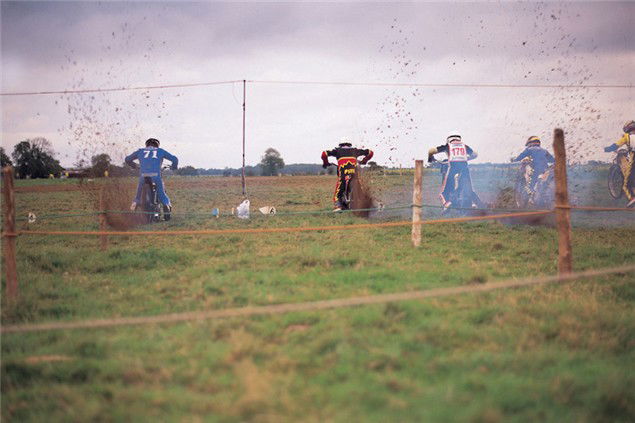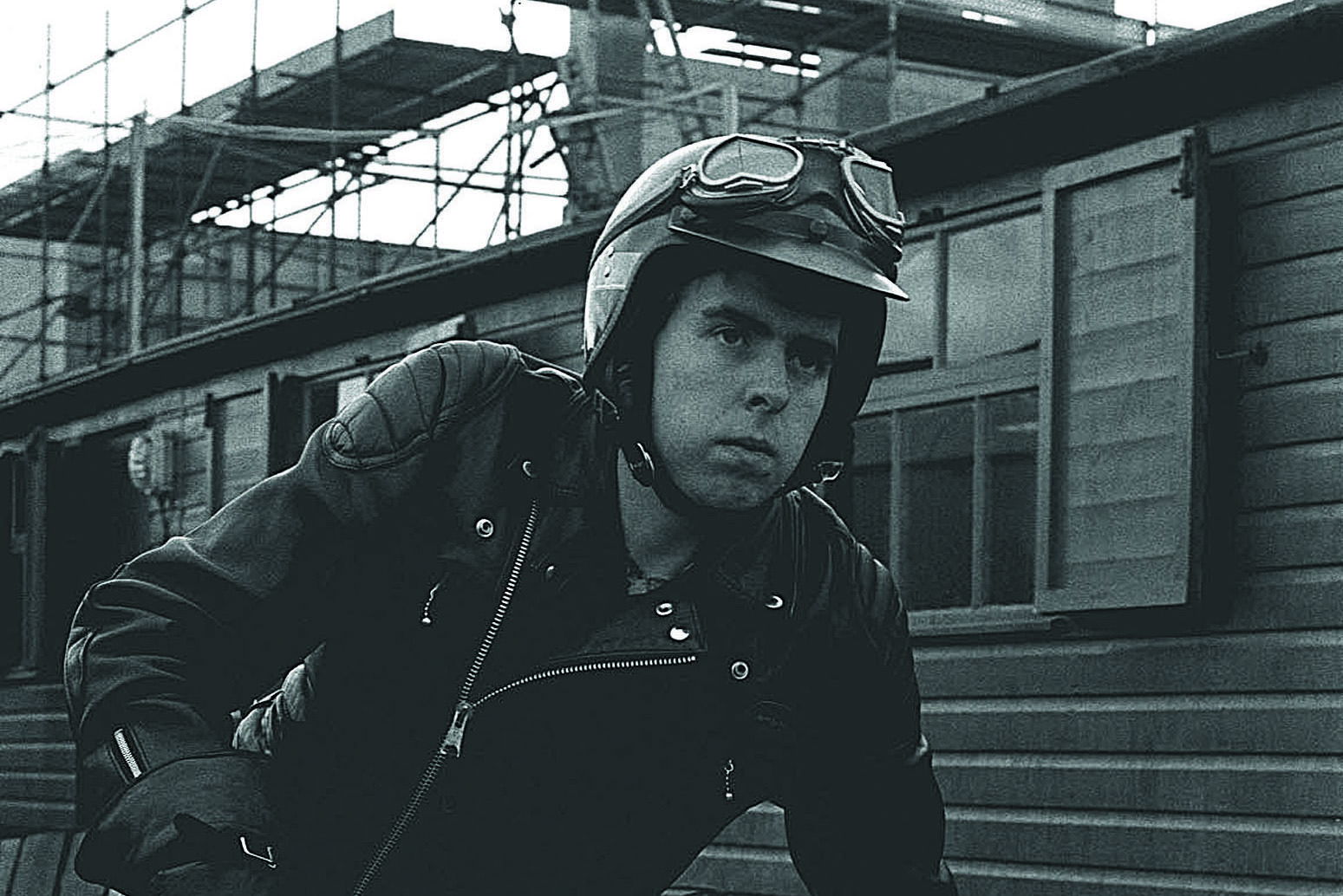The Grass Roots of Grass Track
Tearing a groove in to a field with an adventure in the world of grass track racing


The Carpenters are On Top Of The World via a superannuated PA system. And if the late Karen Carpenter is looking down on creation, what she will see is a large field, a selection of stout stakes and several hundred yards of rope marking out an oval course.
"Can you get that bloody racket turned down?" a gnarled competitor asks Clerk of the Course, Dennis Osborne. "You can't hear yourself think when you're stuck under one of them speakers." Dennis gives the request his fullest attention and as Karen's tones subside, the bark of 500cc singles and 1000cc fours tears into the chill air of deep, rural Hampshire.
This is grass track racing: mud, methanol and as mixed a bag of spectators and competitors as you're ever likely to see - anywhere. From grizzled veterans of the green to three-year-olds in team overalls. Everyone describes it as a family sport and the riders' entries in the refreshingly old-school programme lend weight to the description.
There's Mitch Godden from the Godden grass dynasty, Malcolm Simmons, doyen of speedway and grass and a whole raft of Hiscocks, Kinchins and Banks's, solid pillars of the grass establishment. This is a family sport for family people. Generous thanks are given to the farmer for his field, programme adverts include 'prompt and courteous service from Rob Beale, cesspit and liquid waste emptying service.' And it's entirely possible the generous portaloo consignment will be emptied by Rob.
Trawl around the spectators lining the 480 metre oval and there's everything from outright professionals to casual rank amateurs lured by the fluorescent markers leading from the A303 to Finkley Manor Farm. Some folks have set up beach-style windbreaks and even awnings. A world of Thermos and collapsible chairs unfolds as the burnt methanol fumes drift across the pasture.
The bikes of grass track
Farm Implements
The basic layout is simple: dope-burning 500cc single, steel tube frame, sprung front and rear ends. But it's the levels of development, adjustment and build within the 500 solo class that fascinate. The current fave frame is the monoshock Nu-trak, with fully adjustable suspension geometry, but older items from Antig, Dula and Maximum can still get results in the right hands.
The Czech Jawa is the most popular powerplant at the moment, followed by the Italian GM lump, and British Godden units are still doing the business in the right hands. These engines run total-loss oil systems: castor oil carried in the frame top-tube is pumped in and then out of the engine - no recirculation. And they suck cool-burning methanol to keep engine temperatures down and power outputs high. Brute simple.
The trick with set-up is to get the gearing spot-on and make sure there's just the right balance between traction and wheelspin by adjusting frame and swingarm geometry.
Two-speed gearboxes are Bewley items and the laid-down engine configuration is now a must for big-time racing if you're planning to spend any time at the front. You won't be needing brakes at National level either.
Tractor Boys
With a 1000cc upper-limit (and a possible 1045cc for next season) Yamaha EXUPs and R1s and Kawasaki ZX-10s are the favoured lumps. Outright power is important, but not as vital as getting drive. With 150bhp on tap through a 4.00 x 18" trials tyre (speedway pattern for dryer surfaces), set-up is vital.
A huge range of adjustment via the rear wheel spindle is largely what makes the difference between an outfit that will steer beautifully with no grip and one that has plenty of drive but won't turn. Needless to say, hurtling towards the trackside scenery at full bollocks unable to alter your trajectory is not ideal.
Chassis are mostly Steer devices (made by a bloke called Mick Steer), although the odd Antig or SGM can also be found. Gearbox internals are substituted for a strong, simple two cog set-up and the punishment these things get has to be heard to be disbelieved.
Oh, and sidecars are allowed brakes.
The Salisbury Sizzler is one of the staples of a grass track season turned inside-out by the foot and mouth epidemic. A medium-sized event, it takes its place in the calendar alongside such classics as the Bonfire Burn-up, Wimborne Whoppa and Ace of Aces. No one bills a grass track meeting simply as a grass track meeting, there have to be strong alliterative and hucksterish elements to any event. If the organizers of the somewhat tediously titled British Grand Prix sold it as the Donington Park Dust-up, there's no telling what amount of walk-up ticket sales they could generate.
Even riders nipping over to a local field for a couple of hours practice can't just say they're nipping over to a local field for a couple of hours practice. It'll be announced as the Shakedown Showdown, Top Field Tear-up, or somesuch.
The 'Sizzler', as anyone in the know refers to it, is organised by the Salisbury Motorcycle and Light Car Club. Whether or not a 150bhp, methanol-burning Yamaha R1-engined sidecar outfit qualifies as a Light Car is less important than how violently it tears up the turf in a riot of four-cylinder noise and commotion. Thirty feet of roost thrown high into the air amid the caterwauling of R1s and EXUPs bouncing off the rev-limiters, six abreast into turn one is on the goose-bump side of spectacular and it's plain to see why this fearsomely simple sport has such a dedicated following.
"It's the adrenaline," says Tony Miles, sidecar passenger. "I used to watch and then started ten years ago as a passenger. If you want to learn then you're young enough to learn." Tony is 40. Another Tony, Tony Beaminster is 55. He's another that used to watch, started spannering, then ended up passengering; with a broken back, right leg and both collarbones to show for it. "Yeah, it is exciting, no question," he says. "And it's a family sport alright - you can't do it unless you've got the backing of the wife."
Grass track and speedway share oval tracks, similar (but by no means the same) machinery and a high percentage of riders who compete at both. Kelvin Tatum, three times British Masters grass track champ and speedway world finalist is well qualified to explain the not-so-subtle differences. "First thing: speedway is essentially a team sport, grass is individual. And a good speedway rider will generally make a good grass track rider. The thing with grass is the surface, there are bumps and ridges and you have to deal with that. A speedway track is smooth and it can shock you coming to the grass from speedway - really shake your bones. And you don't need to slide so much on grass, tracks are longer so you can try to keep corner speed up."
And it is fast. Solos and sidecars get away with two speed gearboxes, the idea and the reality being that putting down so much power relative to the grip available means the rear wheel almost acts as a slipping clutch. Gas it and as the rear tyre gradually hooks up, the revs have risen and the bike/outfit has picked up enough speed to pull the higher gearing as traction increases.
Riders are always searching for the right gearing and have to be able to predict the best gearing and best corner lines as track conditions change. A good rider is always searching for grip and experience of different tracks (which themselves are always changing day-to-day, season-to-season) is almost as valuable as horsepower.
With the resurgence of speedway comes a steady revival in grass track racing, even though this has been one of the more difficult seasons for a sport that relies heavily on a healthy rural environment for its wellbeing. The atmosphere is a lot like watching a football team engaged in a local derby, throaty, cider-fuelled shouts of "Goo'orn Ambrose" can be heard above the din and it's as much a pageant for the people as a performance for the riders. The evidence of traditional bunting over the finish line is testament to that. But wrapped up in all the near-razzmatazz of village fete meets raucous freestyle ploughing competition is a sport that's purity is its key attraction: "It's really raw," says Tatum. "But if you can do it with finesse, the sensation of being able to master charging around a rough old surface on a pretty basic bike is really something." Believe.

